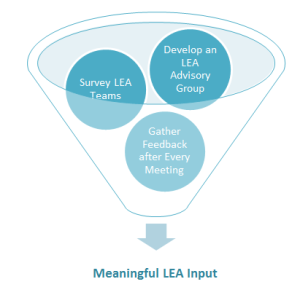Student Learning Objectives (also known as SLOs, Student Growth Targets, and other aliases) are gaining momentum nationally as one measure being implemented by states and districts within their new educator evaluation systems. Briefly, SLOs are long term, measurable academic goals that teachers (and administrators) set for students.
While many states and districts are implementing SLOs, there are also big concerns about SLOs: How do we make them valid and reliable? What assessments can be used to measure student progress, especially in subjects like art, music, foreign languages, and physical education? Do SLOs really mean more testing? What is a year’s worth of growth, anyway?
SLOs ask hard questions of educators; questions that states and districts are often unprepared to answer. Instead of retreating to easy answers that emphasize compliance from educators, stop and think about the opportunity created by the need to grapple with and implement SLOs. Based on UPD’s experience in supporting SEAs and LEAs in the work of designing, implementing, and managing SLOs, there are some golden opportunities for reform that can be missed if leaders aren’t thinking in the right ways:
•Growth is a complicated puzzle: Yes, SLOs are designed to measure growth. But do all your teachers and administrators agree on what equates to a year’s worth of growth? Given where a student starts the year, what can educators reasonably expect in terms of improvement over the course of a year? Do educators know their content well enough to be able to envision the skills and content for their class stretched along a scale and spanning the timeline of the instructional interval, whereby they can measure student growth? Given the difficult implementation of Common Core, probably not. These questions, which are central to our role as educators, present an opportunity to think about new content standards and how both teachers and students interact with those standards in different ways.
•Student target setting is key: Yes, SEAs and LEAs ask teachers to set growth targets for their students based on historical and baseline data, which can feel like another task on a teacher’s endless to-do list. However, any push towards individualized instructional planning and delivery is a good one. The target setting process requires that teachers think through each of their students at the beginning of every year, including where he/she has been academically, and where he/she needs to go next in their learning. The implications for that kind of work reach far beyond teacher evaluation. Between having to dive deeply into new curriculum and planning to facilitate individual students’ growth, this is an opportunity to significantly impact student learning.
•Don’t let (a lack of) assessments derail you: Part of the difficulty of implementing SLOs is deciding which assessments teachers can use to document student growth. Leadership will spend a lot of time worrying about what tests can be considered valid and reliable, and how to deal with core subject areas versus art, music, physical education, and other subjects that do not traditionally make use of standardized assessments. A ready-made answer might be to simply buy assessment systems to cover all grades and subjects, but this would mean missing the opportunity. Stop. Do not pass go. Leaders, go back to the table, pull in your best teachers and look for innovative assessment practices in your schools. Don’t spend money on new assessments in the very year state assessments are changing. Don’t make teachers feel that tests are the only way to measure student growth. Do the hard work of bringing educators together and start defining performance standards. Think of this as the opportunity to do really meaningful professional development on new standards by asking teachers to engage and figure out together what assessments, rubrics, performance tasks and projects make the most sense and provide multiple and diverse ways to document student growth.
•And again (in case you weren’t paying attention), engage educators: teacher evaluation is a controversial subject for obvious reasons. Put your money where your mouth is when you say that these systems are about designing supports for teachers and creating opportunities for teacher leadership. Bring teachers and administrators together from around your LEA/SEA and have them collaborate on the very tough questions SLOs raise. They are not tough because they are related to evaluation, they are tough because they raise fundamental issues in education reform and in teacher practice, and there are no easy answers. Value the collaboration and the process over finding The. Right. Answer. If there were one right answer, everyone would be doing it. There isn’t one – free yourself from trying to find it.
The minute SLOs become a compliance exercise (whether it’s compliance from teachers in following district guidance or compliance from LEAs in following SEA policy), the opportunity to think and collaborate and push our own practice has been lost. Grab the opportunity SLOs provide and make the most of it.
Written by Laura Weeldreyer, a consultant at UPD Consulting



 Photo by
Photo by 
